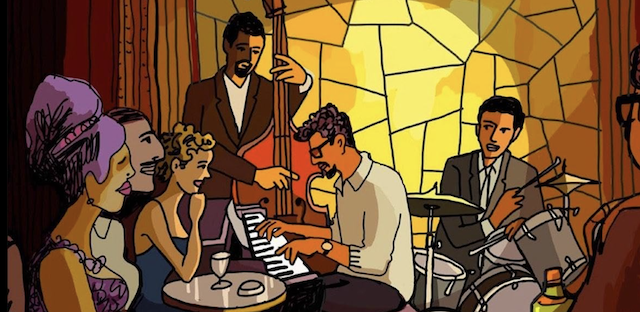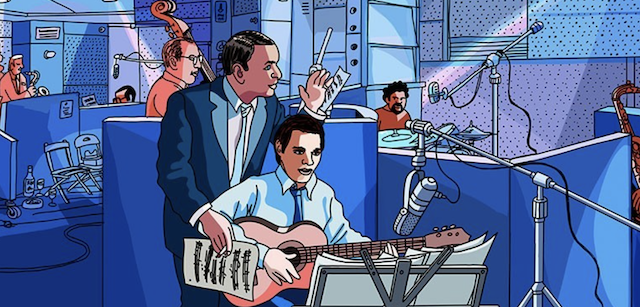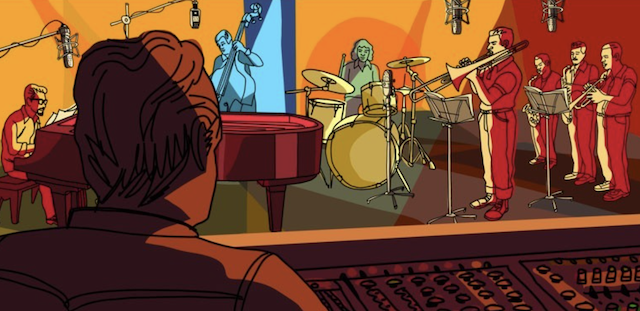
©Sony Pictures Classics
They Shot the Piano Palyer : A New York music journalist goes on a quest to uncover the truth behind the mysterious disappearance of young Brazilian piano virtuoso Tenorio Jr. A celebratory origin story of the world-renowned Latino musical movement Bossa Nova, They Shot The Piano Player captures a fleeting time bursting with creative freedom at a turning point in Latin American history in the 60s and 70s, just before the continent was engulfed by totalitarian regimes.
Rating: PG-13 (Smoking and Some Violence)
Genre: Drama, Music, Animation, Musical
Original Language: English
Director: Fernando Trueba, Javier Mariscal
Producer: Cristina Huete, Serge Lalou, Sophie Cabon, Bruno Felix, Janneke van de Kerkhof, Femke Wolting, Humberto Santana
Writer: Fernando Trueba
Release Date (Theaters): Limited
Runtime:
Distributor: Sony Pictures Classics
Production Co: Constellation Productions, Prima Linea Productions, Fernando Trueba Producciones Cinematográficas, Les Films d’ici Méditerranée, Gao Shan Pictures, Submarine
 ©Sony Pictures Classics
©Sony Pictures Classics
Exclusive Interview Director Fernando Trueba
Q: How did you discover Francisco Tenorio Jr.? Was it through your character journalist Jeff Harris or did you stumble across his music beforehand?
Fernando Trueba: It was through Jeff Harris; he’s my alter ego. The way I discovered Tenorio is quite similar to the way he discovers Tenorio in the movie. I was making a movie in Brazil and bought that record which was just reprinted, a record which has not been available for 50 years. I bought it because some of my favorite musicians were playing on it, like Pablo Moura and Raul de Souza. Then there was this pianist… I had never heard of Tenorio.
I started to get interested and looked for other records where he was playing and then found out that he had only one record as a leader, but this record at the time, was not available — even in Brazil. It was not in print or anything — it must have been 2005. I found one CD of that record in Japan through eBay. The only one I could find at the time was on the internet. I bought it and was so happy when it arrived in Madrid from Tokyo. That’s how I first heard Tenorio and I still have the Japanese CD.
Q: That’s a great story. You really captured the essence of the color and sound of those times. You wanted the audience to have a vivid experience throughout the film like what you did with Chico and Rita — a wonderful film. What was the significant decision to tackle this film as an animation rather than like a straight out documentary?
Fernando Trueba: When I discovered Tenorio, I conducted an investigation for several years, trying to find the most possible people related to Tenorio, his life or to his death and disappearance. In 2005, 2006 and 2007, I did almost 150 interviews, mostly in Brazil, but also in Argentina and the United States. Only 33 ended up in some fragments in the movie. If I had done a conventional documentary, it would have been a series of close-ups of people talking about a dead man, saying, “Oh, he was great.
I loved him so much. I played with him here or there or wherever.” But I didn’t want to perpetrate another crime against Tenorio. I didn’t want to treat him as a dead [person]. I wanted, symbolically, to bring him back to life for the audience, in great colors, playing when he was young, with his wife, son, and in the studio recording with friends. I thought it would be great to do it in animation.
At that time, my only experience in animation was my film “Chico and Rita.” I realized I could introduce real characters in fiction. “Chico and Rita” was almost like a fairy tale. In this film, you get to see, here and there, Charlie Parker, Dizzy Gillespie, Thelonious Monk or whoever. In that sense, people really believe it was Dizzy playing. I found that animation was the right language for this story.
Q: This film introduced information about jazz performers throughout. We learn about the talent of all the musicians involved. You have a vast knowledge of jazz music but did you find out anything new while making the movie?
Fernando Trueba: The influence of Brazilian music in the American music community at the time of bossanova was enormous. Not only did Ella Fitzgerald record Brazilian music, so did Sarah Vaughn, everyone. Sinatra did two records with [Antonio Carlos] Jobim. I have records of Sarah Vaughn with Milton Nascimento, Ella Fitzgerald singing Brazilian songs with the Duke Ellington Orchestra, et cetera, et cetera. Jobim became like a classical composer and his pieces are now standard in America today, but not only in America, but in the world;’s music everywhere, even in Japan.
The Japanese very much like jazz and Brazilian music. I have an American friend who’s a jazz producer and sometimes we’d talk and say, maybe jazz wouldn’t be alive if it wasn’t for the Japanese and French audiences who had, through the years, been the most incredible lovers and fans of jazz. It was incredible when I was doing this investigation, I discovered this story in the movie about Ella Fitzgerald playing in the Copacabana Palace Hotel. She was leaving every night to go to the bars and clubs where bossanova was happening at that moment.
I thought it was a pity that it wasn’t documented. It was written about in newspapers. The journalists tell that story too, but there’s no recording of that at the time, there’s no images of it. So I say with the magic of movies and the magic of animation, let’s do it. In “Chico and Rita,” there was a moment which inspired me to do that because Chano Pozo, the Cuban percussionist, was very friendly with Dizzy Gillespie and they did records together.
He was a friend of Charlie Parker’s and they would play together many times, but never recorded. So I decided, let’s hear them together. I did a scene where they are playing the standard “Tin Tin Deo,” with Charlie Parker and Chano Pozo. I recreated that because I think that’s a gift for the audience. They can go to a moment that you can’t go to in any other way. That’s the magical thing about movies. That’s why I did that scene with Ella Fitzgerald.
 ©Sony Pictures Classics
©Sony Pictures Classics
Q: In this film, you bring in Javier Mariscal, a Spanish artist and designer, to co-direct this film. Throughout the film, you have different sections: New York, Rio de Janeiro, and the club scene. In order to create a different tone, you use different styles of animation. How did you work on the different sections to create the atmosphere you wanted, crafting each other to fit what you felt like the atmosphere that you created?
Fernando Trueba: Mariscal Javier is incredible. He loves architecture and he loves to draw, to make drawings of towns. He has incredible drawings. When you see “Chico and Rita” at the beginning, there is a big, big aerial shot of Havana. Javier drew for days and days, house by house. If you are Cuban, you can recognize real houses there.
There’s so much detail. He did that with New York and Havana in “Chico and Rita.” For this film, he recreated New York, Rio de Janeiro and Buenos Aires. He’s great at that. I remember that that was the origin of “Chico and Rita.” He had been trying to convince me to do something together, to make an animation film.
I was always saying to him, “Javi, I’m not an animation guy. I’m a live-action director. You should do it yourself.” One day, I was at his studio in Barcelona and he had just come back from a holiday in Cuba. I found a drawing scrapbook like this, and it was his drawings of Havana in the holidays.
I started to look page by page, and it was so beautiful. I told him, “Javi, that’s the movie you should do.” And he says, what do you mean? This animation movie you are always talking about, you should make a story, a movie that takes place in this Havana of yours, that is even more beautiful than the real one. That is the beginning, the first moment of “Chico & Rita.” And we ended up making that movie together.
Q: Talk about choosing Jeff Goldblum as narrator Jeff Harris?
Fernando Trueba: We are friends. We did a movie together many years ago in Paris and Madrid. We’ve been friends since then. We never lost contact. He has the best voice that I know. I remember buying a David Mamet play in an audiobook because Jeff’s voice was on it. I love his voice. When you see Wes Anderson’s “Island of Dogs,” all the voices are great actors, but Jeff’s voice is on another level. It’s incredible because he used his voice as a jazz player. You never know how he’s going to deliver up the next lines.
Q: How challenging was it to bring all these elements together — the animation, investigating the story plus a layer of historical context throughout the film? That makes this film so engaging because it’s separate from other animation or documentaries.
Fernando Trueba: I realized very soon when I decided to write the screenplay that in order to tell the story of Tenorio, you have to give the audience a glimpse of the musical context in Brazil at the beginning of the 60s where a figure like Tenorio and many others started in music.
In order to understand Tenorio’s story, you should give a glimpse or as much information as you can of the historical political context in Argentina at the moment he disappeared. There’s these two contexts because the story goes from one to the other. Sadly his career was very short. He was not even 35 when he was killed. So, it’s very important to give all this historical and musical context to understand his life.
Q: In learning about Francisco Tenorio and, at the same time, how much music influences our life, what do you want audiences to take away from this film?
Fernando Trueba: The idea for me is to think of someone who goes to the theater, then comes home and starts listening to Tenorio and Brazilian music in general. That’s the idea, that one would start talking to his friends about [the music]. There are a lot of people, even young people, who have never heard that music before [who are discovering it because of the film]. That’s what’s going on, so for me, that’s the perfect scenario.
 ©Sony Pictures Classics
©Sony Pictures Classics
Check out more of Nobuhiro’s articles.
Here’s the trailer of the film.

